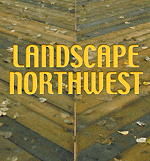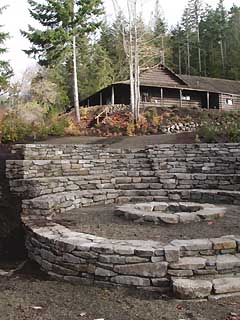
Surveys
DJC.COM
April 19, 2001
Keeping history alive
Pascoe Landscape Design

|
Seattle is rich in landscape history. From traditional estates to Modernist compositions, modest hobby gardens campgrounds, there are many opportunities to enrich our surroundings by giving new life to a historic landscape.
Perhaps the best known of our historic landscapes are the ones created by the Olmsteds.
For owners of Seattle residential estates the oft-cited Olmsted-designed garden refers to the stepson and son of Frederick Law Olmsted, Sr., John Charles Olmsted and Frederick Law Olmsted, Jr.
John Charles is best known for planning and designing the system of Seattle parks, parkways and boulevards still evident today. During the early 20th century, the Olmsted brothers planned residential developments such as the Highlands and specific estates.
While the work of the Olmsted brothers is well known in Seattle, lesser-known landscape architects and garden designers have contributed to the our historic fabric. Many of these designers had contact with or worked directly with the Olmsted brothers as part of their Seattle field office.
Alex McDougal, who served as the Highlands superintendent for 25 years, was employed by the Olmsted brothers in the initial design of the Highlands in 1909. Originally trained as a civil engineer, he subsequently designed estates and gardens in the Highlands in the late ‘20s and early ‘30s.
During the 1930s and 1940s, a looser, more rustic approach to design defined park construction. As an extension of the Arts and Crafts movement, this style of design can be seen in surviving landscape and gardens of custom bungalow and craftsman residences.
More contemporary landscape architects and designers ushered in a new era of Modernist spatial organization, planting design and material usage. In particular, nationally recognized landscape architects Thomas Church, Larry Halprin and Garret Eckbo made significant contributions to estate and institutional landscapes in the Northwest. Local designers such as Rich Haag adopted this idiom and transformed it through the use of regional planting materials.
Historic property owners can undertake a step-by-step process for preserving their historic landscapes under the guidance of designers trained in the process of preservation, restoration or adaptive re-use.
Adaptive re-use recognizes the original design intent while accommodating required changes in use. Through careful consideration of the physical and cultural context of historic designed landscapes, it is possible to create appropriate interventions and preserve historic character-defining elements.
These elements contribute to the historical significance and value of a residence. While this process is ideally applied to an entire landscape, it can address a single feature such as a perennial flower garden, water feature or a path.
When choosing a designer to assist with the preservation, restoration, renovation or modification of a historic designed landscape, seek out individuals or firms whose background includes a broad education in the liberal arts, landscape architectural training, and related project experience.
A professional with a background in landscape architectural history, historic preservation, archival and field research, horticulture, cultural and physical geography, architecture and allied arts, and management can best direct efforts on the scale of individual gardens to entire estates.
Additional guidance may be obtained from State Historic Preservation Offices, local preservation commissions, and the National Park Service. Archival searches are invaluable. Local, regional, and national searches are often required to objectively establish and verify original design intent.
For the recent renovation of a North Seattle estate, Pascoe Design conducted a search at the Puget Sound Regional Archives and discovered tax record photographs taken during the Works Progress Administration in 1937. Another search at the Smithsonian Archives of American Gardens furnished an article documenting a 1930 Garden Club of America garden tour taken two years after the initial construction of the garden.
The following steps are usually part of the preservation, restoration, renovation, or modification of a historic designed landscape:
Historical research: Research is essential before undertaking any alterations or treatment. Research data can help establish period(s) of ownership, occupancy and development, and elucidate associations and characteristics that make your historic designed landscape significant.
This data also provides an objective datum for decision-making when undertaking restoration, renovation or modification, and inform a maintenance schedule, historic interpretation and compliance with local and state preservation requirements if you are seeking a protected status of historic designed landscape.
The National Park Service suggests conducting a search of primary archival sources, including: “historic plans, surveys, plats, tax maps, atlases, U. S. Geological Survey maps, soil profiles, aerial photographs, photographs, stereoscopic views, glass lantern slides, postcards, engravings, paintings, newspapers, journals, construction drawings, specifications, plant lists, nursery catalogs, household records, account books and personal correspondence. Secondary sources include monographs, published histories, theses, National Register forms, survey data, local preservation plans, state contexts and scholarly articles.”
Preparing period plans: Often a historic design plan can be located, but this does not always mean that the plan was completely carried out. Using archival resources such as those outlined above, the found landscape today may be delineated against what was originally built and what was originally intended. Period plans following a timeline of property ownership can graphically document the known development of a landscape and provide a means of interpolation and informed conjecture to fill in the gaps.
Inventorying and documenting existing conditions: The physical evidence of a landscape, its existing conditions and historic research documentation should all guide preservation, restoration, renovation or modification efforts.
Documenting existing conditions requires intensive field survey, archival searches and consultation with other preservation-related professionals and adjacent property owners. The overall goal of an existing conditions inventory is to create a detailed baseline of the landscape and documentation of character-defining elements such as historic plants, topographic features, path alignments, garden structures and detailing, views and view sheds, and spatial relationships to adjacent architecture.
The existing conditions inventory is a foundation for further analysis of continuity and change, cultural significance, integrity, and design intent of the landscape.
Pascoe Design and Planning has completed several projects that typify the successful application of these steps for garden renovation and adaptive re-use.
Originally designed by Charles McDougal, restoration of the North Seattle estate involved an intensive initial archival search. No original plans or details could be located, so analysis of the original designer’s intent required fieldwork to visualize the remnants of strong primary and secondary axial layout.
A Garden Club of America article and tax record photographs conveyed the garden’s character within the first eight years of original establishment. The axial scheme has been strengthened and complemented by a new secondary axis connecting the old service wing and newly remodeled kitchen with an herb garden and future gazebo. Other improvements included an amphitheater, formal terrace, parterre, kitchen, winter gardens and a great lawn.
The Driscoll garden is situated on Hood Canal. The garden is part of an adaptive reuse of an existing WPA-era log cabin meeting hall into a private residence. Detailing of the lawn, terrace, barbecue, badminton court, amphitheater and fire circle are based directly on the rustic vernacular style present in local, state and national park designs of the 1930s and 1940s.
Extensive research of period construction methods provided a basis for onsite discussions with a local stonemason. Granite is used throughout to convey age and permanence while making reference to the glacial erratics common to the area.
Justin Fallon Dollard is an associate at Pascoe Landscape Design and Planning, where he specializes in site design, historic preservation and adaptive reuse. His work has been published nationally.
Other Stories:
- Seattle adapts to life at the top
- Shedding light on the watershed
- Going digital
- New views of sustainable site design from Rainier Vista
- Giving street trees a better chance
- New rules may kill off pesticide use
- Seattle Chinese Garden: a people place
- LEED and the landscape architect
- Private projects become urban environments
- Inviting nature back to the neighborhood
- New respect for the land drives highway design
- Expanding services in times of slowdown:
Thoughts on surviving and thriving with clients - Common ground
- Designing for the journey
Copyright ©2009 Seattle Daily Journal and DJC.COM.
Comments? Questions? Contact us.